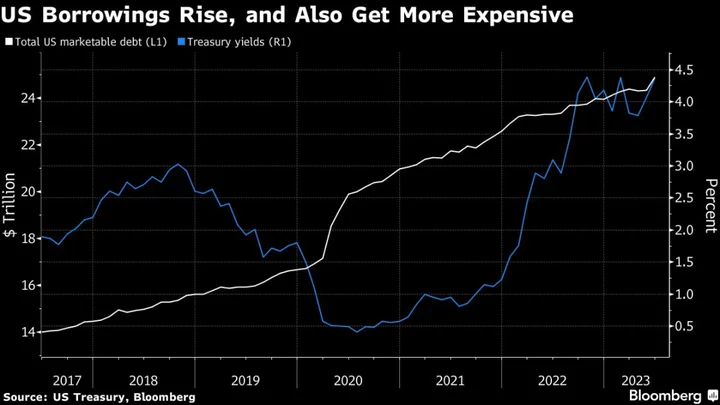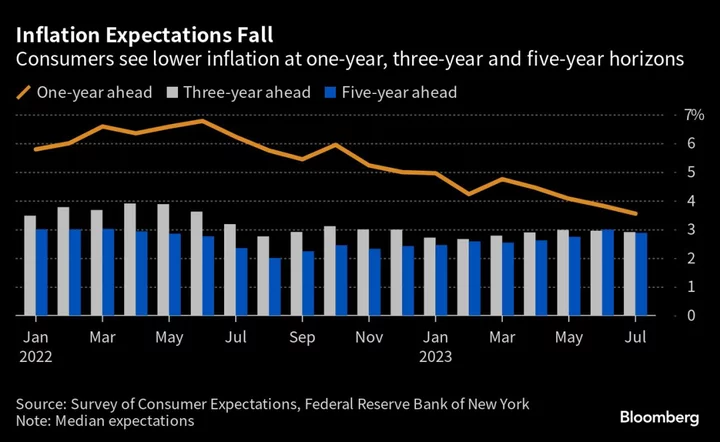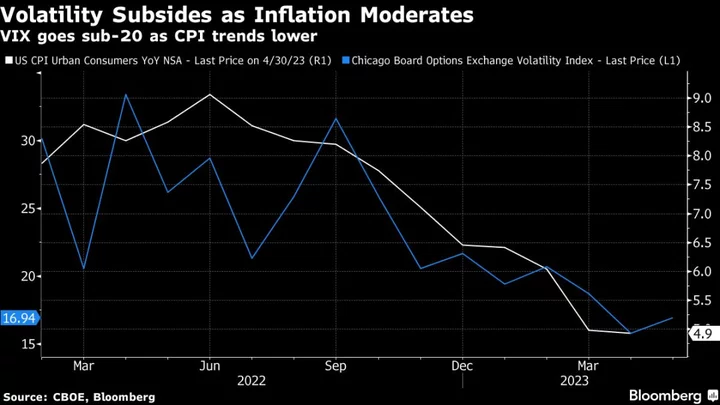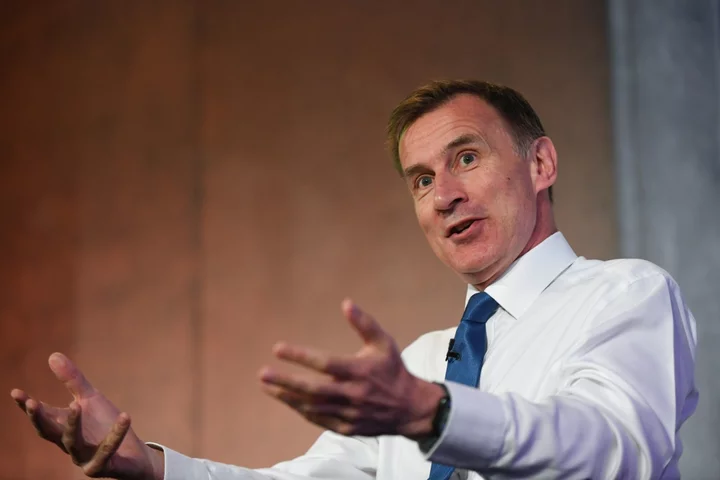Long-dated US Treasuries headed for their worst week of the year amid signs of unexpected resilience in the US’s economy and fresh reasons to fret about its ballooning budget deficit.
The yield on 30-year securities has climbed almost 25 basis points over the past three sessions, returning it to levels last seen in mid-November when inflation was still above 7%, more than double the current rate. Ten-year borrowing costs rose to around 4.13%.
The selloff is dashing the bet of some investors that 2023 would prove to be the “Year of the Bond.” Hot labor-market data is raising concern the Federal Reserve will have to push up interest rates even further to cool inflation. Traders are bracing for Friday’s employment report.
Adding to the pressure, Fitch Ratings’ downgrade of US debt and a glut of looming bonds sales from the government have put a spotlight on the country’s fiscal outlook. The Bank of Japan’s acceptance of higher yields in its market has also contributed.
Bill Ackman, founder of Pershing Square Capital Management, threw his weight behind the rout via social media, while JPMorgan Chase & Co. analysts said the moves are likely just a precursor to a long-term structural shift in yields as public debt mounts.
“With $32 trillion of debt and large deficits as far as the eye can see and higher refi rates, an increasing supply” of Treasuries is assured, Ackman wrote in a post on X, the platform formerly known as Twitter. “It is hard to imagine how the market absorbs such a large increase in supply without materially higher rates.”
Ackman said he’s placing sizable bets on declines in 30-year Treasuries using options, both as a hedge against rising stocks, and also because there’s a strong case for yields to keep going higher. Yields are also likely to rise due to the Fed’s plans to carry out quantitative tightening by reducing the $8.2 trillion balance sheet it built up buying Treasuries and mortgage-backed debt, he said.
What Bloomberg’s Strategists Say...
“Fitch was the weatherman with its US downgrade, telling us about the downpour we can see for ourselves just by taking a glance at the fiscal data. In short, the US faces a perfect storm of a vertiginous fiscal deficit, a near-historically swollen debt load, ballooning interest-rate costs and collapsing tax revenues.”
— Simon White, macro strategist
Click here for full report
In contrast, famed investor Warren Buffett said he had been buying Treasury bills in recent days and would likely continue. “The only question for next Monday is whether we will buy $10 billion in 3-month or 6-month” T-bills, Buffett said on CNBC.
Volumes in put options on 30-year Treasury futures — which are wagers on higher yields — rose above 100,000 contracts on Wednesday, the highest since March.
For JPMorgan Chase’s Alexander Wise and Jan Loeys, the ultimate question is where inflation-adjusted rates eventually go as they maintain a forecast that the real US 10-year yield will reach 2.5% over the coming decade.
The growing fiscal burden is “one of the most important forces driving the projected long-term increase in real yields,” they wrote in a note to clients.
Two former US Treasury secretaries, Hank Paulson and Timothy Geithner, also urged Washington policymakers to address the country’s challenges. “Our fiscal trajectory is concerning,” Hank Paulson said Wednesday in an interview for Bloomberg Television’s Wall Street Week with David Westin. According to Geithner, “you want to move the system to act before it’s late and hard.”
Real yields in long-dated Treasuries also surged this week, with the 30-year real yield jumping about 25 basis points to trade at the highest level since 2011 near 2%, while the 10-year rate approached 1.8%.
The market moves led both the inflation-adjusted and the nominal yield curve to steepen sharply, as investors demanded more risk premium to hold longer Treasuries in the face of a potentially more challenging fiscal outlook.
The term premium for owning a 10-year US bond has risen sharply in recent days to its highest level since early March, according to a widely followed model from the Federal Reserve Bank of New York. Term premium in Treasuries has been suppressed since 2016, as global central banks, led by the BOJ, expanded their bond purchase policies.
Read More: BOJ Shock Has Wall Street Gaming Out the Global Spillovers
Treasuries were already languishing this year, disappointing investors who had anticipated a rally once Fed rate hikes pushed the economy toward recession. With economic data instead remaining relatively robust, Fitch’s decision and an unrelated decision by the US Treasury to sell more debt put the focus squarely on the boom in US government borrowing.
Returns from the two ends of the US yield curve are diverging. Longer-term Treasuries have dropped 1% this year, compared with a 0.5% gain for a broader gauge of US debt, according to Bloomberg indexes.
Fitch still expects a recession, putting it at odds with the Fed and a growing proportion of analysts who predict the central bank will succeed in taming inflation and engineer a soft landing.
This week’s downgrade was based on the medium-term fiscal outlook, “which is characterized by rising deficits and government debt,” said James McCormack, global head of sovereign and supranational ratings for Fitch in Hong Kong.
Treasury 30-year yields climbed as much as 10 basis points to 4.27% on Thursday. The 10-year yield rose as much as 9 basis points to 4.16%.
US yields are “at a critical level,” said Khoon Goh, head of Asia research at Australia & New Zealand Banking Group Ltd. in Singapore. The next major 10-year level is around 4.35% or 4.4%, he said.
Fitch’s move will focus investors on the deterioration in the US fiscal position, but that’s probably already priced in, according to Stephen Miller, an investment strategist at GSFM in Sydney.
“I don’t think it is likely that yields go much higher from here, and if they do then I think I would be buying them,” he said. “The more important dynamic is that the Fed has the measure of inflation.”
For his part, Pershing Square’s Ackman said part of the attraction for shorting longer-maturity US debt is that it acts as a hedge against the potential that higher long-term yields will hurt stocks.
There’s potential for 30-year yields to rise toward 5.5%, and it could “happen soon,” he said. “There are many times in history where the bond market reprices the long end of the curve in a matter of weeks, and this seems like one of those times.”
--With assistance from Ruth Carson, Alice Gledhill, James Hirai, Michael Mackenzie and Aline Oyamada.
(Adds Warren Buffet’s comment, context on real yields and updates prices throughout.)









